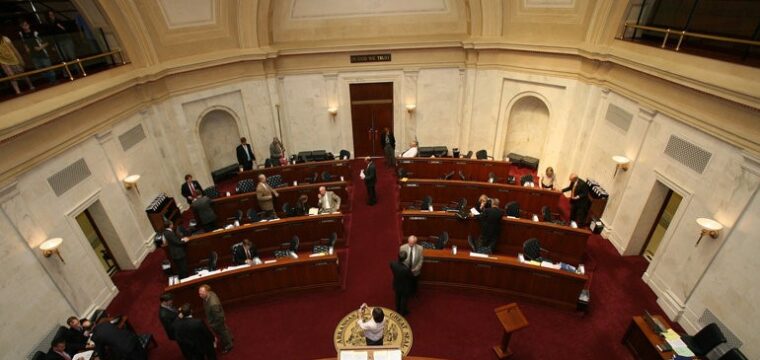Re-printed from the ‘Governing the States and Localities’ website.
A concise look at 10 of the most important issues states will take on in 2015, along with five others that also bear watching.
Affordable Care Act
For the nation’s endlessly controversial health-care law, 2015 initially looks a little bit like 2012, with lots of uncertainty hinging on a decision by the U.S. Supreme Court. States that want to get a head start against the possibility of disruption will have to act quickly.
The high court has agreed to consider a challenge to the law focusing on four words in the statute — “established by the State” — that could ultimately undo the law’s mandate that everyone has to have insurance. Plantiffs say that phrase means that subsidies to offset the cost of health care — received by about 85 percent of the more than 8 million enrollees in the first year — are available only in states that established their own online marketplaces, not in the 32 states where marketplaces were created by the feds.
Opponents of the suit call it an absurd fixation on a drafting error that makes no sense within the full context of the law. Regardless of the merits, if the Supreme Court upholds the challenge, subsidies will stop flowing in states using the federal exchange, leading to premium spikes that will render coverage unaffordable for many. As more people drop out, the exchanges could be left with a coverage base made up primarily of sicker people, driving up premiums further.
The states most ardently opposed to the law will likely do nothing to head off this potential problem. But others will consider changing to a state-based exchange system to avoid losing the subsidies if the Supreme Court upholds the challenge. Among states thought to be in this category are Delaware, Illinois and Iowa.
That path has been made easier by the precedent set in Idaho, New Mexico, Nevada and Oregon, all of which use or have used the federal technology platform while retaining state-based exchange status under the Department of Health and Human Services. But states opting for this choice will need to move promptly to establish full-fledged state systems with independent governing boards, and they may have to appropriate substantial sums from their budgets. “An exchange is not just a website,” says Tim Jost, a health law expert at Washington and Lee University.
The Republican Congress will likely mount piecemeal attacks on other portions of the health-care law after staging symbolic efforts to repeal the entire act. Republicans will try to abolish various taxes on the health-care industry that help pay for the Affordable Care Act and also seek to end the mandate that requires employers above a certain size to offer coverage to their workers.
Finally, there is the law’s tax on high-cost health plans, known as the Cadillac tax, which disproportionately hurts state and local governments that offer top-quality benefits to make up for low salaries. Given that the strongest opponents of the Cadillac tax are public employee unions, this effort may stand less chance of enactment than other attempts to alter the law. — Chris Kardish
Funding CHIP
An estimated 2 million children could lose health-care coverage if Congress does not extend funding for a major public health insurance program by September. Since 1997, the state Children’s Health Insurance Program (CHIP) has provided benefits to children in families with incomes too high to qualify for Medicaid but too low to afford private insurance. States administer CHIP, but the federal government covers about 70 percent of states’ cost, on average, so the program would undergo a radical downsizing if federal funding went away. Roughly half of the 8 million children on CHIP would have to leave the program. Some would find other types of health insurance, but roughly a quarter of the children on CHIP would likely be uninsured.
Historically, CHIP has received bipartisan support, and polling shows that most voters want funding for the program to continue. Nonetheless, lawmakers may get bogged down in debates over how CHIP ought to change in light of the Affordable Care Act. That law was supposed to offer a partial alternative to CHIP by allowing families to take advantage of subsidized insurance plans on state exchanges, but an oversight in the law commonly called the “family glitch” has meant that the tax credits aren’t available to many CHIP families.
“I don’t think either party wants it on their hands that 2 million children become uninsured,” says Joan Alker, a professor at Georgetown University. But the uncertainty surrounding CHIP is already causing headaches for states, which have to draft budgets early in the year and may need to prepare for significant cuts in insurance coverage if federal funding disappears. The financial impact would vary by state, but in the aggregate, states stand to lose more than $5 billion. — J.B. Wogan
Public Pensions
The booming stock market of the past few years has helped stabilize many public pension plans around the country. But 2015 will be a difficult year for states that haven’t been stocking their pension funds the way they are supposed to. New accounting rules will cause these plans to appear significantly worse off than they were a year ago. The changes will likely spur more governments into making changes aimed at paying down their plan liabilities, particularly in states, such as Illinois and Pennsylvania, that have been slow to address the problem.
In simple terms, the new rules created by the Governmental Accounting Standards Board (GASB) will force two major changes. First, they will require pension plans to apply a more conservative formula in calculating the actuarial value of plan assets. The new formula applies to governments that have not been making their full actuarial payments. These plans, which typically have a high unfunded liability, will now look even more unhealthy in their fiscal 2014 annual reports, which some states started releasing late last year.
The second big change will come up later this year as governments begin filing their comprehensive annual financial reports for fiscal year 2015. GASB will require governments to report unfunded pension liabilities on their balance sheets, instead of relegating them to the notes section of the report. This will have a profound impact on a number of governments’ perceived financial positions, as some plans have billions of dollars in unfunded liabilities. “The impact could have serious political consequences,” says Paul Angelo, an actuary with the firm Segal Consulting. “Although it doesn’t change the actual cost of government, someone who doesn’t like pensions is going to look at that and say, ‘See, you’re insolvent because of this giant pension liability.’”
The new accounting rules are unlikely to affect credit ratings, because the formal status of pension plans isn’t changing — what’s changing is the way in which the health of these plans is reported. — Liz Farmer
School Testing
When governors and state school officials released the Common Core curriculum standards four and a half years ago, the new program was touted as a fair and accurate way to measure student achievement across state lines and cultivate the analytical skills that many argue American children will need in order to compete on a global scale.
But the past year has seen a growing pushback against the standards, and as students begin taking tests based on the core curriculum this spring, lawmakers at the state and federal level will likely be talking about chipping away at them.
Although the standards were created almost entirely by the states, critics see them as reflecting priorities set out by the Obama administration. Incoming Senate Republican leaders aim to limit the federal government’s role in promoting test-based accountability and also challenge the frequency of the tests, an issue that concerns even prominent Democrats.
The Common Core is a list of things students at each grade level should know or be able to do in English and math. The standards attracted little controversy at first, as 45 states quickly adopted them. But the federal government has played a role in the program’s implementation. It has offered grant money and reprieves from earlier education mandates to those states that install Common Core or other “college-and-career-ready” standards. The Department of Education has given hundreds of millions of dollars to state associations designing standardized tests that the students in participating states will take starting this year.
Those tests have to hew closely to the standards to be useful, and the standards have to be relatively uniform to help policymakers get a sense of how their students stack up with those in other states. But over the past year or so, 11 states have decided to use tests of their own, while another 13 are considering that option, according to Education Week. That’s not counting the handful of states that went further last year and repealed the standards altogether.
There’s a strong possibility more states will strike out on their own in 2015, either before the tests can be given, or later, in response to lower test scores that will likely accompany the more challenging standards in their first year. As support for Common Core continues to splinter and states assert their independence, the coming year will be an important test of the new system’s political viability.
And while officials are keeping one eye on the first year of Common Core test scores, they’ll be training the other eye on Capitol Hill. Sen. Lamar Alexander of Tennessee, a leader among Republicans on education issues, has already said he wants to amend the 2001 No Child Left Behind law to leave states free to decide how they evaluate teachers. Alexander also wants to consider eliminating some annual testing. That’s an idea that’s caught on in states as varied as Texas, a stronghold of test-based accountability, and Connecticut, where Gov. Dannel Malloy wants to start by relieving high school juniors of the burden of taking both state exams and college entrance tests. — Chris Kardish
Transportation Funding
Nearly every spring, in states all over the country, transportation advocates proclaim that “this will be the year” elected leaders finally face up to long-neglected infrastructure needs. More often than not, those claims do not pan out.
There are signs, though, that this year may be different, even in some of the states with acute infrastructure problems. Those include Iowa, Georgia, Michigan, Texas and Wisconsin. All of those states have governors who, fresh off their November elections, said transportation funding increases would be among their top priorities for the coming year.
Incoming Texas Gov. Greg Abbott aired a TV commercial during his campaign that showed him in a traffic jam complaining that he could move faster on the road in his wheelchair than cars and trucks could travel. Abbott called for dedicating revenues from vehicle sales taxes toward transportation. He also said he wanted to spend a bigger share of the state’s fuel taxes on transportation.
Wisconsin Gov. Scott Walker has long expressed a desire to overhaul the state’s road funding system. After his 2014 re-election, Walker’s transportation department floated a proposal to raise fees on electric vehicles, hike diesel fuel taxes and add a wholesale fuel tax.
Transportation advocates are increasingly turning to state efforts to boost funding, because Congress has been unable to agree to any major new revenues since the last long-term surface transportation law expired in 2009. Instead, federal lawmakers have kept money flowing to the states through a series of short-term patches. The latest temporary fix expires in May, just as the construction season begins. Even a last-minute deal to keep funds flowing would be problematic because it would not give state agencies enough planning time to start any new projects beyond basic upkeep.
The role of transit will come up in funding debates at both the state and federal levels. A vocal contingent of Republicans in the U.S. House recently tried to exclude transit from receiving federal highway money, although that effort was eventually defeated. In Georgia, lawmakers are considering new money for roads but not for MARTA, Atlanta’s transit system, which, unlike most such systems, receives no dedicated funds from the state. Incoming Maryland Gov. Larry Hogan voiced opposition during his campaign to building two light-rail lines, one in Baltimore and the other in the suburbs of Washington, D.C., but has since backed away from those comments. Large Democratic majorities in the state’s legislature could oppose any efforts to pull the plug on those projects. — Daniel C. Vock
The Cost of Water
“The era of cheap water is really coming to an end,” says Tom Curtis, the head of government affairs for the American Water Works Association (AWWA). Rising water prices will affect decisions by states and localities across a whole range of issues.
There are many reasons for the surge in water costs. In older cities, pipes installed as long as a century ago need to be replaced. It could cost more than $2 trillion over the next 25 years to replace and expand drinking water and wastewater systems nationally, according to a rough estimate by the AWWA.
Booming Sun Belt regions, facing the prospect of future shortages, are spending large sums looking for new sources of water in distant areas. They are not only tapping new aquifers and building reservoirs, but are also exploring the idea of recycling water, essentially putting cleaned and treated wastewater back into drinking water systems. Meanwhile, San Diego County is building a desalinization plant on the Pacific Ocean.
At the same time, many systems must make major upgrades as a result of federal enforcement actions. The Environmental Protection Agency has focused on reducing the amount of raw sewage and untreated stormwater that enters the nation’s lakes, rivers and waterways. That can be hugely expensive to fix in places where wastewater and stormwater share the same pipes, as is the case in much of the Northeast and Great Lakes regions. Many local governments are considering upgrades to their stormwater systems, treatment plants and other facilities to improve their resilience in the event of natural disasters and climate change.
In the short run, utilities are passing higher costs on to consumers. That poses huge problems for low-income customers. As water bills soak up a bigger percentage of customers’ incomes, more people fall behind on their payments. That leaves utilities in a tight spot, as officials in Detroit discovered last year. There, the utility cut off water to thousands of residents behind on their bills, prompting major protests, a reorganization of the water authority and a rebuke from the United Nations. — Daniel C. Vock
Specialty Drugs
Sovaldi, the hepatitis C drug that costs $1,000 a pill, has presented state governments with ethical and financial quandaries since its approval by the U.S. Food and Drug Administration in December 2013. Clinical trials show the pill can have a cure rate greater than 90 percent. Yet if state Medicaid agencies covered everyone eligible for the treatment, the cost would exceed $50 billion. That is why states such as Colorado and Pennsylvania are enacting strict criteria to determine when patients on Medicaid can obtain the drug, essentially waiting until they are seriously ill before prescribing the high-cost treatment. By doing so, states may be missing an opportunity to prevent liver cancer and other diseases that develop in the later stages of hepatitis C. The manufacturer of Sovaldi, Gilead Sciences Inc., argues that public officials aren’t taking into account the full economic benefits of prescribing the drug; they say its high price tag reflects its capacity to cure the disease rather than manage symptoms over many years, meaning it should lead to large savings in the long run.
States that try to ration use of Sovaldi are sure to invite litigation, but lawsuits won’t resolve the larger issue: Sovaldi is just the first of a wave of highly effective but expensive specialty drugs and therapies expected to hit the market in the near future to address multiple sclerosis, Alzheimer’s, cancers and other difficult-to-treat diseases. There is precedent for Medicaid covering the cost of expensive specialty drugs for certain diseases, including HIV and cystic fibrosis, but Sovaldi is different because of the much larger population with the disease (3.2 million people) and the prevalence of hepatitis C among Medicaid recipients.
The National Association of Medicaid Directors has proposed a series of federal solutions, among them price controls, a waiver tying Medicaid payments to successful outcomes, or the creation of a supply chain through which the federal government would buy large quantities of the drug at a discount and sell it to states at a more affordable price. Until Congress takes up the issue, however, states will be left to experiment with policies that limit the use of specialty drugs for those in the highest need. — J.B. Wogan
Corrections
Overcrowded prisons are a problem in a large number of states. Alabama, which has struggled with the issue for years, houses nearly twice as many prisoners as its facilities were originally designed to hold. California remains under a federal court order to reduce its prison population. And county sheriffs in Arkansas report backlogs of inmates waiting to be transferred to state facilities. In all, about half of the states reported that their prisons were at 99 percent or more of operational capacity at the end of 2013.
Lawmakers in at least a handful of these states are likely to tackle the issue later this year. In many cases, inmates are admitted to prisons not for new criminal charges, but for parole violations. In the interest of keeping inmate populations at a manageable level, policymakers may seek to relax rules requiring parole revocation for relatively minor infractions such as failing to take drug tests or missing meetings. Alabama is among the states weighing new rules that will make it easier for prisoners to qualify for parole. Lawmakers in some states could be receptive to establishing or expanding early release programs, especially given the aging prison population.
Part of the discussion also will involve the possibility of revised sentencing laws. This will mean finding alternatives for lower-level drug offenders, such as drug treatment courts. Similar changes in the juvenile justice system may receive consideration in South Dakota and West Virginia. Utah’s Criminal and Juvenile Justice Commission issued 18 recommendations in November to curb the state’s prison population, including a proposal to reclassify first-time drug possession as a misdemeanor. — Mike Maciag
Tax Policy
Many states are primed for changes in their tax laws this year, and with an especially large crop of Republican governors coming into office, most of the changes will be in the direction of lower income tax rates. Quite a few of the recently elected GOP governors made campaign pledges to cut both personal and corporate taxes.
Arkansas Gov.-elect Asa Hutchinson is calling for immediate reductions for middle-income earners to be eventually expanded across all wage brackets. A campaign proposal from Arizona’s incoming governor, Doug Ducey, would cut both personal and corporate rates over time, with a goal of eventually eliminating these taxes altogether. The most common approach to make up for the revenue lost in tax reduction will be to pair income tax cuts with broader or higher sales taxes.
Republican-controlled states that already trimmed taxes in recent years still may want to chip away further in this legislative session. North Carolina passed comprehensive tax cuts in 2013, but legislators may explore the possibility of further reductions in capital gains taxes.
But some states may find their tax-cutting efforts curtailed by the results they have seen from earlier reductions elsewhere. In Kansas, Gov. Sam Brownback succeeded in pushing through substantial cuts to personal income taxes in 2012 and 2013. Recent revenue projections for the state paint a grim picture of the state’s finances, however, with total revenues dropping 11 percent in fiscal 2014.
In some other states, there will be efforts to change tax law to provide more revenue for broadly popular programs. Democratic Pennsylvania Gov.-elect Tom Wolf, for example, has indicated he’ll prioritize K-12 education.
Severance taxes could be on the table in states where fracking has accelerated. A bill to raise oil and gas taxes stalled last year in the Ohio Legislature, but the issue is likely to return in 2015. Similar discussions over severance tax rates could play out in North Carolina and Pennsylvania. The question of how to tax Internet transactions is also likely to come up in a number of places. — Mike Maciag
Carbon Emissions
States have long pursued divergent courses when it comes to addressing climate change through carbon reduction. Proposed federal rules have done little to get them moving in the same direction.
Last June, the Environmental Protection Agency (EPA) unveiled a proposal that called on states to reduce carbon emissions, on average, 30 percent below 2005 levels by 2030. The individual reduction targets range widely — from 11 percent in North Dakota to 72 percent in Washington state — depending on what regulators thought each state could realistically achieve. Reduction targets in coal-producing states are on the lower side.
By and large, states are not pleased with the project. Many state officials complain that the EPA is overstepping its authority, calling for expensive changes that will raise energy prices and cost jobs. In September, 15 Republican governors sent a letter to President Obama asserting that the proposed rules failed to strike the right balance between state and federal authority, and insisting on the need to generate reliable and affordable energy while protecting the environment.
A number of states have joined together in a lawsuit seeking to block the EPA’s rules, which aren’t scheduled to be finalized until June. Others will simply take a just-say-no approach to the rules, refusing to comply in the belief they can wait out Obama until he leaves office. That would throw the issue into the courts, but in the meantime it’s likely that the GOP-controlled Congress will place the whole idea of federal carbon regulation under increased scrutiny.
In October, Pennsylvania enacted a law requiring that its legislature sign off on any state plan to comply with the EPA mandates. That may be a model for other states this year. In addition, at least nine states have passed laws directing their regulators to take economic impact carefully into account when developing carbon reduction plans.
Not all states are reacting negatively. California’s cap and trade system gives it a big edge in complying with federal goals. That system will expand this year to cover a broader range of industries. A group of 13 Western states sent a letter to the administration seeking to ensure that their plans, including regional efforts that cross state lines, will receive due credit.
Until the EPA finishes crafting its rules, states will continue to ask for maximum flexibility in meeting the targets. That is typical in the federal rulemaking process, and the administration has already extended its period for receiving comments in response to pushback from states. Once the EPA publishes its final version of the rules, however, states will have a year to come up with actual plans for meeting the agency’s targets. Some states will be ready to start down that path, while others will be busy gearing up for further political and legal battles. — Alan Greenblatt
Trending: Five More Issues to Watch in 2015
Oil and Railroads
The oil boom on the High Plains — far from most refineries or pipelines — has put a huge strain on the nation’s railroads. While the federal government regulates most aspects of railroads, state and city officials are being thrust into debates over the oil freight surge too. Environmentalists in New York and Washington states, for example, want their governors to block refineries from accepting oil transported by train. North Dakota officials decided to require oil producers to strip out the most flammable components of crude oil before shipping it. And a number of states and cities are revising their emergency preparedness protocols to account for possible derailments and subsequent spills.
The heavy traffic on the rails is affecting other rail-dependent industries, particularly agriculture. Farmers hundreds of miles from oil fields cannot get their grain to market, in large part because locomotives are moving oil instead.
Net Metering
The increasing number of homes and businesses with rooftop solar panels are bad news for utilities who must buy excess power from these installations under “net-metering” requirements. Forty-four states and the District of Columbia have them.
Electric utilities say the arrangements hurt them in two ways: First, they are losing customers to the solar industry. Second, they have to provide an electric grid to their small-scale competitors, who don’t pay for the grid’s upkeep.
So utilities are stepping up the pressure on states and cities to address their concerns. Many utilities want to raise the fixed fees for residential and small commercial customers. Some are also pushing for reductions in how much utilities pay for excess power generated by solar producers, giving small customers less incentive to install solar panels. Arizona is pushing to lease customers’ rooftops so it could install its own solar panels there. The customers would get credit on their electric bills. In San Antonio, CPS Energy wants to aggregate all the solar power sold in its area, acquiring it through a third party in a bidding process.
Pandemic preparedness
Ebola cases in Texas and New York this fall caused a national panic over whether the U.S. was truly equipped to combat a deadly virus outbreak — of any kind. The brunt of that responsibility falls on state and local governments, and the coming year will see discussions about how jurisdictions should best deal with public health preparedness. The approach on the local level could include something as dramatic as restructuring health departments to better coordinate a multipronged response to a full-scale public health attack. At a minimum, states and localities will be reconsidering their health budgets with an eye toward preparedness, and looking for increased federal aid.
In the meantime, hospitals and health centers all over the country will continue to address their disease response and containment protocols. Two states, New Jersey and New York, have already established controversial quarantine policies for people returning to the United States after treating Ebola patients in West Africa. The legality and actual effectiveness of quarantines will continue to be debated as part of the assessment of response readiness and disease containment.
E-cigarettes
So far, states have shown a reluctance to tax and regulate the now-booming e-cigarette industry, and perhaps with good reason. The Food and Drug Administration is just beginning to put in place a federal regulatory regime, and there’s still much that policymakers don’t know about the effects of the product.
Still, three states — North Dakota, New Jersey and Utah — have added e-cigarettes to their list of products banned in legally smoke-free workplaces, and two states, Minnesota and North Carolina, have begun taxing them.
Lawmakers in Alabama, Arizona and Washington state are now talking about taxing e-cigarettes to fill budget holes, and New Mexico and Ohio seem likely to broach the subject. This fuels anger among libertarians that so-called sin taxes have always been more about raising money than about public health.
Ridesharing
In the past few years, cities have seen a surge of app-based driving services, including Uber, Lyft and Sidecar. Under pressure from taxi unions, many mayors have issued cease-and-desist orders to the new companies, but a handful of tech-friendly localities have revised local regulations to welcome them.
So far, states have let cities decide how to deal with this issue, but that could be changing. Last year, Colorado became the second state — after California — to establish statewide rules for ridesharing companies, and the first to do so legislatively. Early legislative activity suggests state approaches are likely to vary in the coming years. One model, considered by Illinois and Michigan lawmakers last year, would make ridesharing a state-regulated enterprise and preempt local oversight of the business. Some states might follow the example of the District of Columbia, where a new law permits ridesharing but also deregulates taxi meter fares when passengers order rides online — a concession meant to make the taxi industry more competitive.








